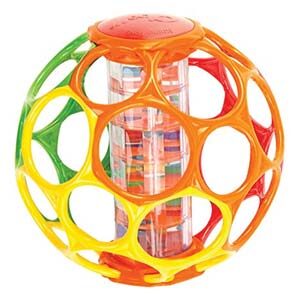Self-control
Toddlers watch a caregiver calm down after an exciting activity with a special toy.



[Invite several toddlers to join you to find out about a new toy.]
 [Hold up the ball and point to the rain stick inside when you describe it.]
[Hold up the ball and point to the rain stick inside when you describe it.]
This toy has different things. Do you see the rain stick inside the ball?
Our toy is also a ball. It can roll on the floor, like this.
[Roll the ball on the floor back and forth in front of you.]
This special ball can make different sounds. Do you remember how our rain sticks made different sounds?
Listen closely!
[Turn the ball over, allowing the beads to fall slowly down. Touch your ears, encouraging toddlers to listen to the sounds of the rain stick inside.]
What do we hear? I heard “pitter patter” as the little balls went down, down, down.
Now I am going to do something different with our special ball. I am going to shake it! Let’s find out what kind of sound our ball makes when I shake it.
[Shake the ball for several moments. You may wish to shake it in different ways, such as fast and slow, high and low.]
Now I am going to roll our ball on the floor again. Listen closely!
[Roll the ball back and forth on the floor in front of you.]
Our ball makes a nice sound when it rolls.
I had fun playing with this special ball and listening to the different sounds it can make! I feel excited!
It is time for me to calm down. I am going to put the ball away and rest. Please watch how I calm down.
[Put the ball in a separate space, not next to you. Relax your arms. Put your hands in your lap. Take several deep, slow breaths. Close your eyes briefly. Quietly hum or sing a familiar song.]
I had fun playing with the special ball. I got excited moving our ball in different ways and hearing different sounds. Then it was time for me to calm down. [Describe what you did to calm down.]
Self-control
A toddler practices calming down with caregiver support after an exciting activity with a special toy.



 Invite a toddler to join you to play with a special toy. Sit facing the toddler and introduce the ball by rolling it to the toddler. Point out the rain stick inside the ball. Encourage the toddler to shake and move the ball to make different sounds. Offer demonstrations of how to play with the ball, if necessary. Describe the toddler’s actions with the ball and draw attention to the sounds made by the ball. Show enthusiasm and excitement for the toddler’s play with the ball. After an appropriate period of play with the ball, explain that playing with the ball made us feel excited and now it is time to calm down.
Invite a toddler to join you to play with a special toy. Sit facing the toddler and introduce the ball by rolling it to the toddler. Point out the rain stick inside the ball. Encourage the toddler to shake and move the ball to make different sounds. Offer demonstrations of how to play with the ball, if necessary. Describe the toddler’s actions with the ball and draw attention to the sounds made by the ball. Show enthusiasm and excitement for the toddler’s play with the ball. After an appropriate period of play with the ball, explain that playing with the ball made us feel excited and now it is time to calm down.
Help the toddler calm down with the following strategies that you also pursue:
Conclude the session by describing the fun of playing with a special toy. We felt excited. Then we calmed down. We are sitting quietly. We feel calm.
Toddlers will enjoy watching you play with this unique toy in Option 1 and interacting with it in Option 2. Some toddlers will focus on the movements they can make with the ball, whereas others may take special interest in the different sounds they hear. Some may prefer to mostly shake the ball and may benefit from your support to try different ways of moving it. Toddlers will also differ in the ease with which they calm down. See the Extra Support tips for ways to help toddlers who may find it challenging to stop shaking or playing with the ball.
Extra support
Enrichment
Materials Needed: blanket, assortment of sound-making toys
Place 3–4 sound-making toys, such as bells and shakers, on a blanket for toddlers to play with. Encourage toddlers to listen carefully to sounds of different toys. Draw their attention to different ways of moving a toy, such as faster and slower. Invite toddlers to put the toys down and sit quietly with you before moving to a different activity. Offer calming-down prompts, if appropriate. Avoid making available the toy used in Options 1 and 2 until all interested children have had an opportunity to participate in one or both of these options.
Materials Needed: Oball™ Rollin’ Rainstick Rattle
Invite children in your care to sit in a circle with legs wide and feet touching their neighbor. Consider placing older children next to young toddlers. Infants can be a part of the circle by sitting on your lap (the ball is designed for children three months and older). Take turns rolling the ball to each child in the circle and encouraging the child who receives the ball to roll it back to you. Before moving to the next activity, invite children to sit quietly for a few moments to calm down. Use calming-down strategies suggested in Option 1.